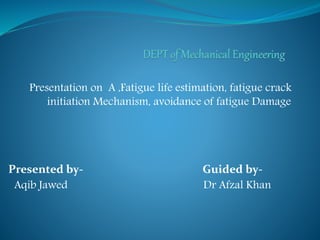
Fatigue
- 1. Presentation on A ,Fatigue life estimation, fatigue crack initiation Mechanism, avoidance of fatigue Damage Presented by- Guided by- Aqib Jawed Dr Afzal Khan
- 2. overview I. Fatigue II. How fatigue occurs III. How start fatigue IV. Fatigue life estimation V. What is S-N curve VI. Failure of a material due to fatigue VII. Mechanism of Fatigue Crack Initiation VIII.Avoidance of fatigue damage
- 3. fatigue in materials science, when materials fails at stresses below the yield point, fatigue is structural damage that occurs when a material is subjected to cyclic loading. Fatigue failure of a crankshaft
- 4. How fatigue occurs Fatigue occurs when a material is subjected to repeated loading and unloading. If the loads are above a certain threshold, microscopic cracks will begin to form at the surface. when a crack will reach a critical size, and the structure will suddenly fracture. The shape of the structure will significantly affect the fatigue life; square holes or sharp corners will lead to elevated local stresses where fatigue cracks can initiate.
- 5. How start fatigue In metals and alloys, the process starts with dislocation movements, eventually continuing slip bands that nucleate short cracks. Fatigue is a often showing considerable scatter even in controlled environments. Damage is cumulative Materials do not recover when rested.
- 6. Characteristics of fatigue Fatigue life is influenced by a variety of factors, such as temperature, surface finish, microstructure, presence of oxidizing or inert chemicals, residual stresses, etc.
- 7. Fatigue life estimation The fatigue life is estimated by S-N curve What is S-N curve? The S-N curve is very useful way to visualize time to failure for a specific material . The "S-N" means stress verse cycles to failure,
- 8. Main Steps in the S-N Fatigue Life Estimation Procedure Analysis of external forces acting on the structure and the component. Analysis of internal loads in chosen cross section of a component, Selection of individual notched component in the structure, Identification of the stress parameter used for the determination of the S-N curve (nominal/reference stress), Determination of analogous stress parameter for the actual element in the structure. Identification of appropriate stress history. Calculation of fatigue damage, Determination of fatigue life in terms of number of stress history repetitions, the number of cycles to failure, N. The procedure has to be repeated several times if multiple stress concentrations or critical locations are found in a component or structure.
- 9. Failure of a material due to fatigue failure may be viewed on a microscopic level in three steps: Crack Initiation: The initial crack occurs in this stage. The crack may be caused by surface scratches caused by handling, or tooling of the material threads ( as in a screw or bolt) Crack Propagation: The crack continues to grow during this stage as a result of continuously applied stresses Failure: Failure occurs when the material that has not been affected by the crack cannot withstand the applied stress. This stage happens very quickly.
- 10. Mechanism of Fatigue Crack Initiation The fatigue life of a material is defined as the number of cycles necessary to form an “engineering” crack, During cyclic loading. Fatigue crack initiation has been divided into two stages: 1. initiation stage that involves the growth of micro structurally cracks 2. propagation stage that involves the growth of mechanically small cracks.
- 11. Initiation of fatigue crack (stage I) In stage I, the fatigue crack tends to propagate initially along slip planes (extrusion and intrusion of persistent slip bands) and later take the direction normal to the maximum tensile stress The crack propagation rate in stage I is generally very low on the order of nm/cycles giving featureless surface
- 12. Initiation of fatigue crack (stage II) The fracture surface of stage II crack propagation frequently shows a pattern of fatigue band. Each scratch is produced by a single stress cycle and represents the successive position of an advancing crack front normal to the greatest tensile stress.
- 13. Factors causing fatigue failure Basic factors A maximum tensile stress of sufficiently high value A large amount of variation or fluctuation in the applied stress. A sufficiently large number of cycles of the applied stress.
- 14. Factors causing fatigue failure Additional factors Stress concentration Residual stress Combined stress Corrosion Temperature Overload Metallurgical structure
- 15. Avoidance of fatigue damage 1. Cyclic stress state 2. Geometry 3. Material Type 4. Residual stresses 5. Size and distribution of internal defects 6. Environment 7. Temperature
- 16. Cyclic stress state Depending on the complexity of the geometry and the loading, one or more properties of the stress state need to be considered, such as stress amplitude, mean stress, in-phase or out-of-phase shear stress and load sequence,
- 17. Geometry Notches and variation in cross section throughout a part lead to stress concentrations where fatigue cracks initiate
- 18. Material Type Fatigue life, as well as the behavior during cyclic loading, varies widely for different materials, e.g. composites and polymers differ markedly from metals.
- 19. Residual stresses Welding, cutting, casting, and other manufacturing processes involving heat or deformation can produce high levels of tensile residual stress, which decreases the fatigue strength.
- 20. Size and distribution of internal defects Casting defects such as gas porosity, non-metallic inclusions and shrinkage voids can significantly reduce fatigue strength.
- 21. Grain size For most metals, smaller grains yield longer fatigue lives, however, the presence of surface defects or scratches will have a greater influence than in a coarse grained alloy.
- 22. Temperature Extreme high or low temperatures can decrease fatigue strength.
- 23. Environmental effects Thermal Fatigue. Thermal cycling causes expansion and contraction, hence thermal stress. Solutions: change design! use materials with low thermal expansion coefficients Corrosion fatigue. Chemical reactions induce pits which act as stress raisers. Corrosion also enhances crack propagation. Solutions: decrease corrosiveness of medium add protective surface coating add residual compressive stresses
